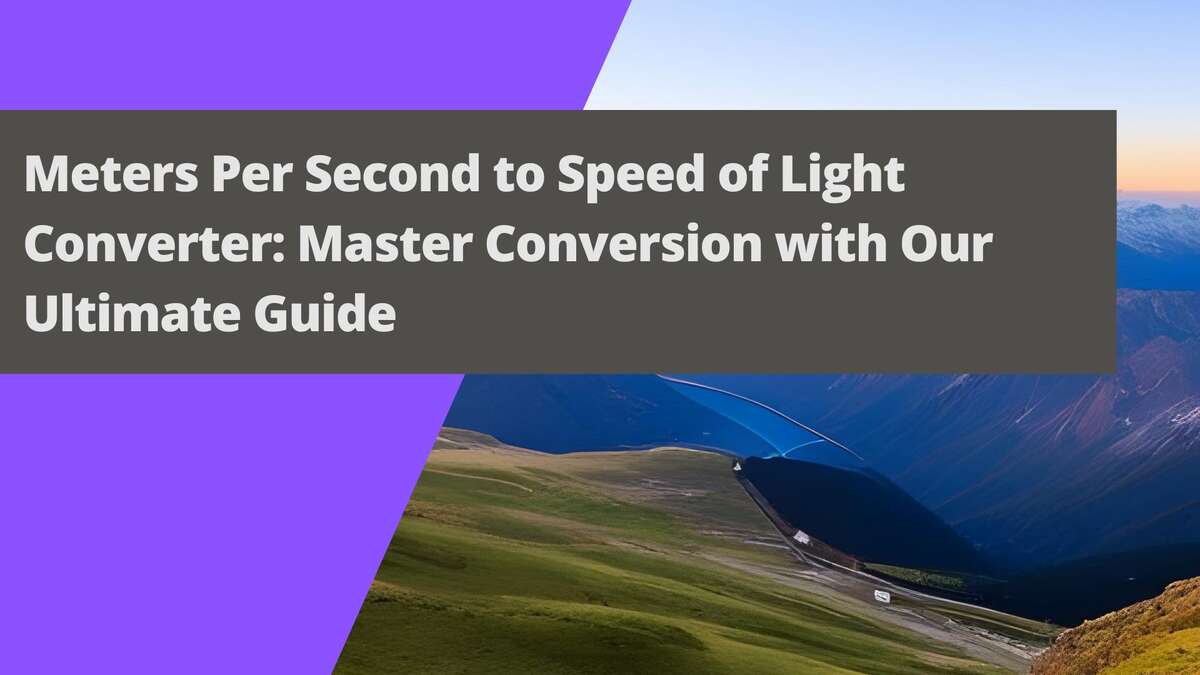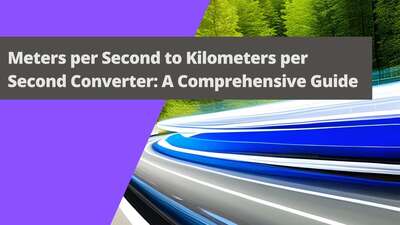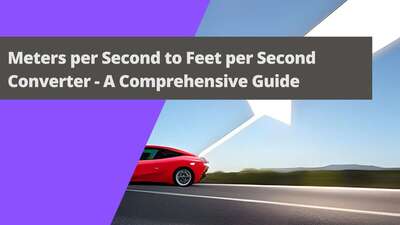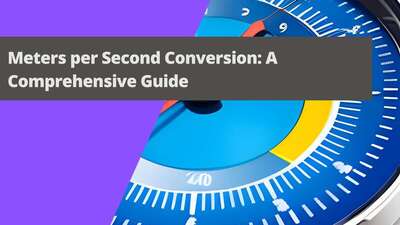Meters Per Second to Speed of Light Converter: The Ultimate Guide

Have you ever wondered how to convert meters per second (m/s) to the speed of light? In this comprehensive article, we will dive deep into the topic, providing you with a step-by-step guide and a variety of real-world examples and applications. By the end, you'll be well-versed in converting meters per second to the speed of light using our handy speed converter.
Introduction
The concept of speed is an essential part of our daily lives. From driving cars to observing the movement of celestial objects, speed is a crucial factor that helps us understand and interpret the world around us. In this article, we focus on converting meters per second (m/s), a common unit of speed, to the speed of light, an essential constant in physics and astronomy.
Definition
Before diving into the conversion process, let's define the two main concepts involved: meters per second and the speed of light.
Meters per second (m/s): A unit of speed representing the distance (in meters) covered by an object in one second. It is widely used in various fields like physics, engineering, and everyday life.
Speed of light: The speed at which light travels in a vacuum. It is denoted by the letter 'c' and is approximately 299,792,458 meters per second (m/s). The speed of light is a fundamental constant in physics and serves as the basis for various theories and equations, such as Einstein's Theory of Relativity.
Formula
To convert meters per second to the speed of light, we use the following formula:
Speed of light (fraction) = (meters per second) / 299,792,458
This formula provides the fraction of the speed of light, which can be expressed as a decimal or percentage.
Explaining
The formula mentioned above calculates the fraction of the speed of light corresponding to a specific speed in meters per second. To better understand the conversion process, let's break down the formula step by step:
- Take the speed in meters per second (m/s).
- Divide the speed in m/s by the speed of light constant (299,792,458 m/s).
- The result is the fraction of the speed of light (in decimal form).
- Optional: Multiply the result by 100 to express the fraction as a percentage.
Conversion Factors and Table
Knowing the conversion factors can help you quickly convert between different units of speed. In this case, the conversion factor for meters per second to the speed of light is approximately 3.3356 x 10-9.
To further facilitate the conversion process, we have created a handy conversion table below:
| Meters per second (m/s) | Speed of light (fraction) | Speed of light (percentage) |
|---|---|---|
| 1 | 3.3356 x 10-9 | 3.3356 x 10-7% |
| 10 | 3.3356 x 10-8 | 3.3356 x 10-6% |
| 100 | 3.3356 x 10-7 | 3.3356 x 10-5% |
| 1,000 | 3.3356 x 10-6 | 3.3356 x 10-4% |
| 10,000 | 3.3356 x 10-5 | 3.3356 x 10-3% |
| 100,000 | 3.3356 x 10-4 | 0.03356% |
| 1,000,000 | 3.3356 x 10-3 | 0.3356% |
Step-by-Step Guide
To convert meters per second to the speed of light, follow this step-by-step guide:
- Find the speed in meters per second (m/s) that you want to convert.
- Visit AmazingConverter's Speed Converter or refer to our meters per second conversion guide.
- Enter the speed in meters per second (m/s) in the appropriate input field.
- Select the 'speed of light' as the target unit.
- Click 'Convert' to obtain the speed as a fraction of the speed of light.
- Optional: Multiply the result by 100 to get the percentage of the speed of light.
For a more in-depth understanding and visual examples, you can check out our YouTube playlist on speed conversion.
Real-world Examples and Applications
Understanding the concept of converting meters per second to the speed of light is not only an interesting academic exercise but also has practical applications in various fields. Some examples include:
- Astronomy: Calculating the speed of celestial objects, such as stars or galaxies, as a fraction of the speed of light can help astronomers better understand the vast distances and motions of objects within the universe.
- Physics: In theoretical physics, especially in the field of relativity, the speed of light plays a vital role. Knowing the speed of particles or objects in terms of the speed of light allows physicists to study and predict their behavior under specific conditions.
- Engineering: In engineering fields like aerospace or telecommunications, understanding the speed of electromagnetic waves and signals in terms of the speed of light can facilitate the design and optimization of devices and systems.
- Education: For students and educators, learning about the conversion between meters per second and the speed of light can deepen their understanding of fundamental concepts in physics and mathematics.
Frequently Asked Questions
How do I convert meters per second to the speed of light?
To convert meters per second to the speed of light, divide the speed in meters per second by the speed of light constant (299,792,458 m/s). The result will be a decimal fraction representing the speed as a fraction of the speed of light.
What is the speed of light constant?
The speed of light constant, denoted by the letter 'c', is approximately 299,792,458 meters per second (m/s). It represents the speed at which light travels in a vacuum and is a fundamental constant in physics.
Why is the speed of light important?
The speed of light is important because it serves as the basis for various theories and equations in physics, such as Einstein's Theory of Relativity. It also plays a crucial role in understanding the behavior of particles and objects at high speeds and is essential for accurately describing the universe's structure and dynamics.
Conclusion
Converting meters per second to the speed of light is an important skill to have in various fields, including astronomy, physics, engineering, and education. With the help of this comprehensive guide, you should now be able to confidently perform such conversions using the formula, the speed converter, or the provided conversion table. By understanding this concept and its real-world applications, you'll gain valuable insights into the fascinating world of speed and the underlying principles of the universe.









